Do tax hikes drive out millionaires?
by CalWatchdog Staff | October 25, 2012 7:44 am
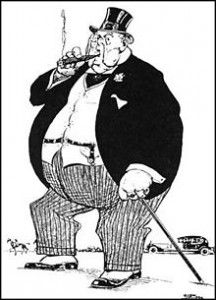 [1]Oct. 25, 2012
[1]Oct. 25, 2012
By John Seiler
Just in time for an election about raising millionaires’ taxes comes a study saying they won’t leave. Instead, when their taxes are raised, they’ll stay and shout, “Thank you, sir! May I have another![2]”
The California Budget Project is touting[3] the study, “Millionaire Migration: The Impact of Top Tax Rates[4].” The study is by two professors, Charles Varner and Cristobal Young, both from the Stanford Center on Poverty and Inequality and the Department of Sociology at Princeton University.
According to the CBP’s summary:
“This new research dispels one of the most persistent myths about state tax policy: that wealthy Californians will leave the state to avoid having to pay a slightly higher tax rate on personal income.
“Using a highly rigorous study design that makes it possible to examine how state tax rates affect relocation over time, Varner and Young looked at the impact of the ‘millionaire tax’ that California voters approved in 2004. Their findings show that a higher personal income tax rate didn’t cause the rich to leave the state and also suggest that the risk of so-called ‘tax flight’ is outweighed by other factors, such as existing ties to family, friends, and career.”
“With California voters turning their attention to the November ballot, this new research undercuts the claim by opponents of Proposition 30[5] that this measure’s personal income tax increase, which would largely affect the top 1 percent, will drive high earners out of the state.”
So the study really is about having an impact on Prop. 30, which could prove crucial in a close election.
Does not compute
However, the study actually does not successfully prove its case. It looks at the effects of Proposition 63, which voters passed in 2004. Prop. 63 raised taxes 1 percentage point on incomes above $1 million to fund mental health programs.
According to the professors:
“This study addresses the following key question: Do changes in California’s top income tax rates lead to changes in the migration of top incomes?….
“This study tracks migration by, in essence, identifying taxpayers who file a California full-year resident tax return in one year and file a part-year / nonresident return in an adjacent year. We calculate the rates of in-migration and out-migration as a percentage of population for different income groups over the period 1994-2007. We then compare migration patterns before and after two recent California tax law changes.”
The other tax change looked at was the 1996 tax reduction, when Gov. Pete Wilson’s 1991 tax increase, which boosted the top tax rate from 9.3 percent to 11 percent, fell off the books.
The study provided a useful graph of the top state rate from when the first income tax was imposed in California in 1935. This is on top of the federal tax rate, I should add, which was 91 percent as recently as 1964.
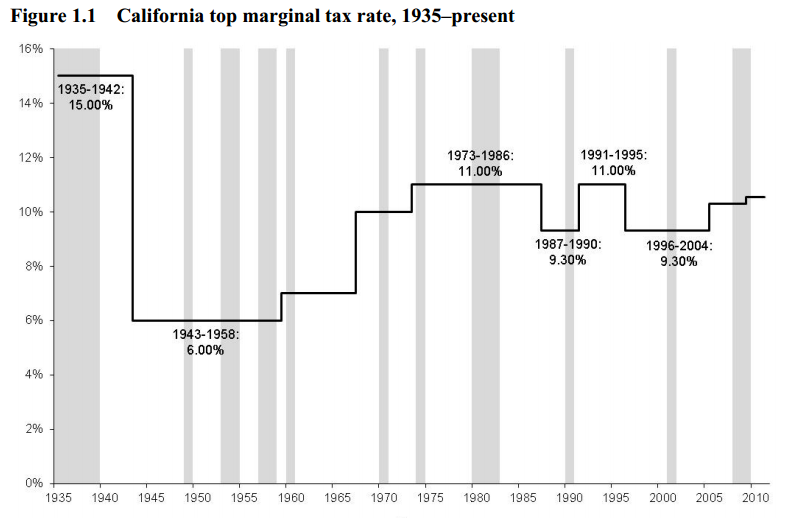 [6]
[6]
And it provided another graph, which shows how progressive California’s tax rate is. Note how quickly the second highest tax rate, 9.3 percent, digs in: at just around $55,000 of income, which is lower-middle class in this expensive state.
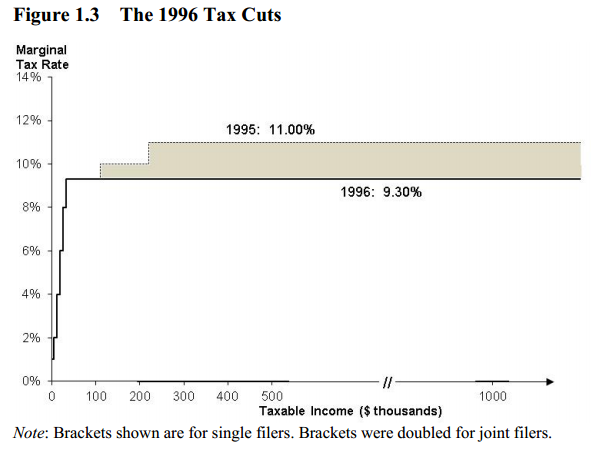 [7]
[7]
The study explains:
“The basic face validity test on overall net migration trends showed no evidence for a tax effect, but top-income tax filers may be different. If they are different—and if tax rates are important factors in their state residency decisions—we would expect to find two patterns in California’s wealthy population. The number of top-income earners would fall after a tax increase and rise after a tax cut.”
And we get another good graph.
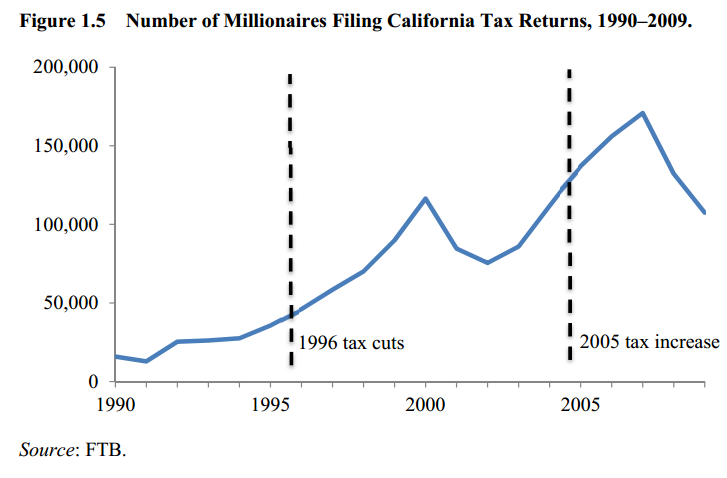 [8]
[8]
Their conclusions are shown in a chart:
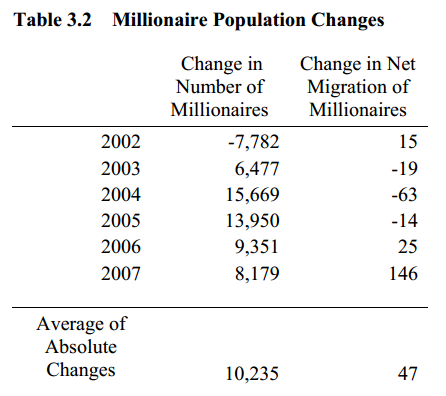 [9]
[9]
So, it would seem that millionaires are unaffected by tax increases, or tax cuts for that matter. The study used control groups of those in different, lower, income groups. Their conclusion: “The only noticeable pattern here is that migration declines with income. Individuals at the very top seem to be more strongly attached to their current state than other slightly less wealthy individuals.”
On the 1996 tax cut, they write: “Migration ‘non-response’ to modest changes in tax policy is also relevant for policymakers considering tax cuts. Just as new top tax brackets do not drive millionaires to flee California or New Jersey (Young and Varner 2011), we do not expect tax cuts to influence top income earners’ state of residency.”
Their conclusion: “We have found no observable effect of two California tax changes on the migration behavior of high-income earners.”
Millionaires stayed
And they concluded that “out-migration declined among millionaires after the tax was passed (both in absolute terms and compared to the control group).”
So the millionaires apparently liked the tax increase so much they stayed to get more punishment.
This also is important:
“Migration is a very small component of changes in the number of millionaires in California. While the millionaire population sees a typical year-to-year fluctuation of more than 10,000 people, net migration sees a year-to-year fluctuation in a range of 50 to 120 people. At the most, migration accounts for 1.2 percent of the annual changes in the millionaire population. The remaining 98.8 percent of fluctuation in millionaire population is due to income dynamics at the top — California residents growing into the millionaire bracket, or falling out of it again.”
But the best explanation of all comes in the last paragraph of the study:
“Most people who earn $1 million or more are having an unusually good year. Income for these individuals was notably lower in years past, and will decline in future years as well. A representative ‘millionaire’ will only have a handful of years in the $1 million + tax bracket. The somewhat temporary nature of very-high earnings is one reason why the tax changes examined here generate no observable tax flight. It is difficult to migrate away from an unusually good year of income.”
That certainly is the case. Most people making $1 million or more a year have enjoyed an extraordinary event, such as a stellar year selling real estate. In other years, they might make only $300,000 or $500,000 a year.
What’s really going on
This is an important study because it is the best attempt anyone is going to make for saying that millionaires don’t leave California because of high taxes. But the study has several flaws.
First, the tax changes studied — the 1996 tax cut and the 2005 tax increase — came during boom times in California. The late 1990s enjoyed the dot-com boom. And the mid-2000s enjoyed the real estate boom. When things are booming, why leave?
The two boom-bust cycles were different. The dot-com boom was a real advance in technology, the commercialization of the Internet beginning in 1995. It was a unique event in world history. When the bust struck in 1999, a lot of companies, and investors, went belly up. But many companies of that era, such as Google, Ebay and Yahoo, survived and thrived, throwing off millionaires like sparks from a dynamo.
The real estate boom was fake, generated by artificially interest rates from the inflationist Federal Reserve Board, too-easy lending policies by the banks, Fannie Mae and Freddie Mac, the Bush administration’s irresponsible Keynesian deficit spending, and other dislocations. It had to end in a bad bust, and it did, beginning in December 2007.
Unfortunately, the Stanford study of millionaires ends in 2007. So we don’t see if millionaires left the state to escape high taxes during the Great Recession, in particular after Gov. Arnold Schwarzenegger boosted the top income tax rate from 10.3 percent to 11.3 percent from 2009 to 2011.
Silicon Valley
But a bigger problem for the study is that Silicon Valley continues to be a unique place not just in America, but on the planet. If you’re a young hotshot programmer with a 180 IQ, whether you grew up in Baltimore or Mumbai, Silicon Valley is the place to be. Austin, Tex., or Redmond, Wash., impose no state income taxes at all. But they’re not the center of the tech universe. Silicon Valley is.
In June 2004, Facebook[10] moved from Massachusetts, which had a top state income tax rate of 5.4 percent. Mark Zuckerberg did not care that California soon would pass Prop. 63 and increase the top tax rate to 10.3 percent. He wanted to be in his Shangra-La[11] in the valley of the silicon.
That happy circumstance is going to continue into the indefinite future for California. Although Apple and other companies are locating many of their operations in more business-friendly states, such as Apple’s gigantic server farm in North Carolina[12], the big brains always will want to live here. With Apple and Google expanding globally, their stock values seemingly rising higher every year, there’s no reason to think this will not continue.
A better study would exempt Silicon Valley millionaires from the statistics and see what the numbers then said. Because the real question is not the one asked by the professors, in their words, “Do changes in California’s top income tax rates lead to changes in the migration of top incomes?”
Rather, the real questions are, first: “Aside from Silicon Valley, where millionaires are not going to leave no matter what, do changes in California’s top income tax rates lead to changes in the migration of top incomes?”
Because that’s what affects most of us. Joseph Vranich used to compile a list of companies leaving California, 254 of which split in 2011[13]. At least some of these companies paid top executives more than $1 million a year. Their exodus hurt local areas outside Silicon Valley.
That’s a main reason California’s unemployment rate, which dropped in September to 10.2 percent, still remains 2.4 percentage points higher than the national rate of 7.8 percent.
Where does the money go?
And the second question the Stanford study doesn’t ask is: “What effect do higher taxes on millionaires have on what the millionaires do with their money?”
As I keep saying, another name for rich people is business and jobs creators. Sure, they like their yachts and Rolls Royces. But there’s one thing rich people like more than such baubles: more money. And they get more money by investing in new business and jobs creation. If more of their money is taken from them through higher taxes, they will have less to invest.
Again, in California this effect is hidden because of the immense creativity of Silicon Valley. There was only one Steve Jobs, and he was born here, raised here and loved living in California. But as successful as he was, and Apple continues to be, their success would have been even greater if the state’s taxes were lower, leaving them more to invest. After all, until Jobs returned in 1997, Apple nearly died.
Companies and entrepreneurs need every advantage they can get in this increasingly competitive global marketplace. Higher taxes, including on supposedly untouchable millionaires, slow the engine that drives California’s prosperity.
- [Image]: http://www.calwatchdog.com/2011/10/13/how-to-get-rich-in-ca-work-for-govt/fat-cat-politician-3/
- Thank you, sir! May I have another!: http://www.youtube.com/watch?v=qdFLPn30dvQ
- touting: http://cbp.org/pdfs/2012/121022_Statement_MigrationResearch.pdf
- Millionaire Migration: The Impact of Top Tax Rates: http://uccs.ucdavis.edu/assets/event-assets/event-presentations/varner_young_paper
- Proposition 30: http://ballotpedia.org/wiki/index.php/California_Proposition_30,_Sales_and_Income_Tax_Increase_(2012)
- [Image]: http://www.calwatchdog.com/2012/10/25/do-tax-hikes-drive-out-millionaires/california-top-marginal-tax-rate-1935-present/
- [Image]: http://www.calwatchdog.com/2012/10/25/do-tax-hikes-drive-out-millionaires/the-1996-tax-cuts-in-california/
- [Image]: http://www.calwatchdog.com/2012/10/25/do-tax-hikes-drive-out-millionaires/number-of-millionaires-filing-california-tax-returns-1990-2009-2/
- [Image]: http://www.calwatchdog.com/2012/10/25/do-tax-hikes-drive-out-millionaires/table-millionaire-population-changes/
- Facebook: http://en.wikipedia.org/wiki/Facebook
- Shangra-La: http://en.wikipedia.org/wiki/Shangri-La
- server farm in North Carolina: http://www.macnn.com/articles/10/02/22/facility.built.upon.225.acres.of.land/
- 254 of which split in 2011: http://www.ocregister.com/articles/moved-342887-companies-texas.html
Source URL: https://calwatchdog.com/2012/10/25/do-tax-hikes-drive-out-millionaires/